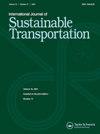确定代表不同驾驶条件的最佳驾驶循环次数
IF 3.9
3区 工程技术
Q2 ENVIRONMENTAL STUDIES
International Journal of Sustainable Transportation
Pub Date : 2024-08-02
DOI:10.1080/15568318.2024.2397647
引用次数: 0
摘要
驾驶周期是车辆排放建模的主要输入之一。然而,天气条件波动导致的驾驶周期变化是车辆排放估算不确定性的主要来源之一。本研究旨在识别和确定能够正确代表不同天气条件下驾驶模式的最佳驾驶周期数。首先,建立一个多变量多元回归模型,以确定影响驾驶模式的最重要天气因素。然后,利用无监督机器学习,根据这些因素识别类似的天气条件。接着,针对不同的天气类型构建了两个驾驶周期,一个是工作日,另一个是周末。然后,使用描述性分析和相似性矩阵来确定在不同天气类型下生成的驾驶周期的相似程度。最后,确定了 15 个驾驶周期,以代表不同驾驶条件下的驾驶模式。本文章由计算机程序翻译,如有差异,请以英文原文为准。
Identifying optimal number of driving cycles to represent diverse driving conditions
Driving cycle is one of the main inputs of vehicle emission modeling. However, the variability of driving cycles due to fluctuations in weather conditions is one of the primary sources of uncertainty in vehicle emission estimation. This study aims to identify and determine an optimal number of driving cycles that can correctly represent driving patterns in diverse weather conditions. First, a multivariate multiple regression model is developed to determine the most important weather factors affecting the driving patterns. Then, similar weather conditions are identified according to these factors using unsupervised machine learning. Next, two driving cycles are constructed for diverse weather types, one for weekdays and one for weekends. Afterward, descriptive analysis and a similarity matrix are employed to determine how similar the generated driving cycles are in different weather types. Finally, 15 driving cycles are identified to represent driving patterns in diverse driving conditions.
求助全文
通过发布文献求助,成功后即可免费获取论文全文。
去求助
来源期刊
CiteScore
8.90
自引率
2.60%
发文量
56
期刊介绍:
The International Journal of Sustainable Transportation provides a discussion forum for the exchange of new and innovative ideas on sustainable transportation research in the context of environmental, economical, social, and engineering aspects, as well as current and future interactions of transportation systems and other urban subsystems. The scope includes the examination of overall sustainability of any transportation system, including its infrastructure, vehicle, operation, and maintenance; the integration of social science disciplines, engineering, and information technology with transportation; the understanding of the comparative aspects of different transportation systems from a global perspective; qualitative and quantitative transportation studies; and case studies, surveys, and expository papers in an international or local context. Equal emphasis is placed on the problems of sustainable transportation that are associated with passenger and freight transportation modes in both industrialized and non-industrialized areas. All submitted manuscripts are subject to initial evaluation by the Editors and, if found suitable for further consideration, to peer review by independent, anonymous expert reviewers. All peer review is single-blind. Submissions are made online via ScholarOne Manuscripts.

 求助内容:
求助内容: 应助结果提醒方式:
应助结果提醒方式:


